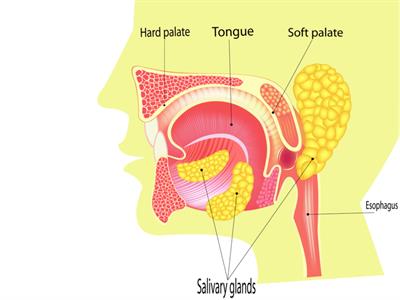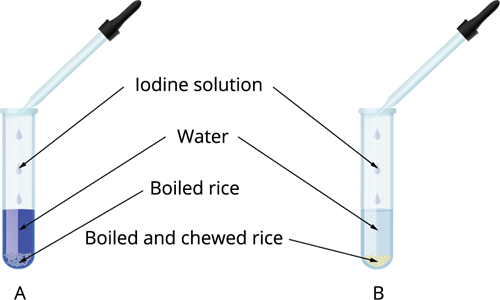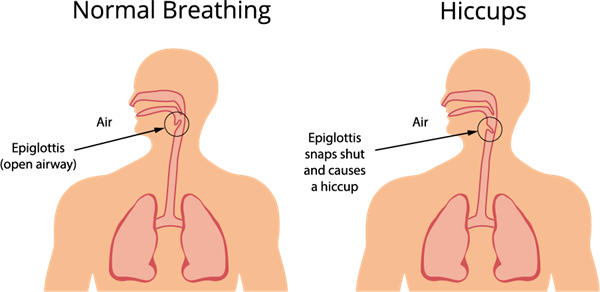
PUMPA - SMART LEARNING
எங்கள் ஆசிரியர்களுடன் 1-ஆன்-1 ஆலோசனை நேரத்தைப் பெறுங்கள். டாப்பர் ஆவதற்கு நாங்கள் பயிற்சி அளிப்போம்
Book Free DemoThe mouth has salivary glands that secrete saliva. There are three pairs of salivary glands present in the mouth.

Salivary glands in mouth
Saliva contains salivary amylase enzyme, which breaks down the starch into simple sugar, maltose.
Experiment demonstrating the action of saliva
Aim:
To study the activity of saliva on starch present in food.
Materials required:
- Two test tubes
- Boiled rice
- Dilute iodine solution
- Water
Procedure:
- Take two test tubes. Label one test tube as \(A\) and another as \(B\).
- Take a spoon of boiled rice and add it to the test tube labelled as \(A\).
- Take another spoon of boiled rice. Chew the boiled rice for \(3\) to \(5\) \(minutes\).
- Add the chewed boiled rice to the test tube labelled \(B\).
- Add \(3\) to \(4\)\(ml\) water in both test tubes.
- Now add \(2\) \(-\) \(3\) drops of iodine solution in each of the test tubes.
- Observe the change in colour seen in both the test tubes.
Observation:
A blue-black colour is produced in the test tube that is labelled as \(A\). There is no colour change seen in the test tube labelled as \(B\).

Change in colour in test tube\(A\);No change in colour in test tube\(B\) Inference:
There is a change in colour observed in the test tube labelled \(A\) as the boiled rice contains starch. In the test tube \(B\), there is no change in colour. The salivary amylase present in the saliva breaks down the starch into sugars. Since there is no starch present in the test tube after the treatment of boiled rice with saliva, there is no colour change to blue-black. Thus, saliva breaks down the starch to sugar in the form of maltose.
Why do we get hiccups?
Sometimes when we eat in a hurry, laugh or talk, we may get hiccups or a choking sensation.
When the food particles enter the windpipe, hiccups occur. The windpipe carries air from the nostrils to the lungs. Food is transported from the mouth to the stomach through the food pipe. Air and food, on the other hand, share a similar passage within the throat. Then, how does food prevents its entry into the windpipe?
When the food particles enter the windpipe, hiccups occur. The windpipe carries air from the nostrils to the lungs. Food is transported from the mouth to the stomach through the food pipe. Air and food, on the other hand, share a similar passage within the throat. Then, how does food prevents its entry into the windpipe?
When we swallow, a flap-like valve called the epiglottis closes the passage of the windpipe and guides the food into the food pipe. If food particles enter the windpipe, the epiglottis closes, and we may get hiccups or a choking sensation. Thus, we cough to clear the blockage in the windpipe.

Hiccups mechanism
Reference:
https://www.studdy.org/activity-2-3-nutrition-in-animals-solution-science-class-7/
https://in.pinterest.com/pin/737605245208011030/